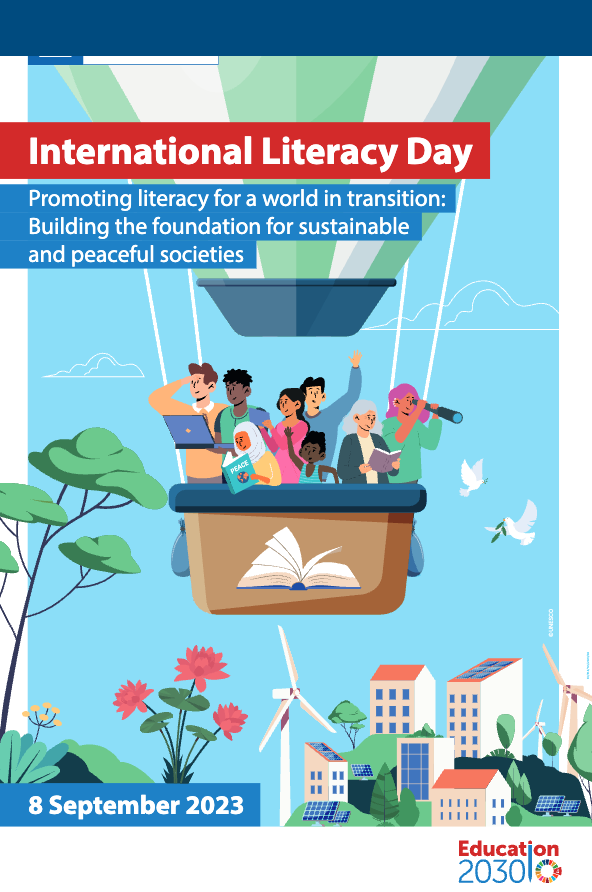Teaching and celebrating international days in World Language classes helps students see the power of learning languages. The International Days in September are particularly special to me. They help me set the tone of what is important in class, they help expand students’ global views, and they help me see how (un)comfortable students are in an immersion-style class. We celebrate International Literacy Day, September 8 and International Dot Day, September 15. In this post, we will only talk about International Literacy Day.
International Literacy Day (ILD) has been recognized on September 8 since 1967, when UNESCO chose this day as a reminder of the importance of literacy as a human right. Each year, UNESCO adopts a theme and the one for this year is “Promoting literacy for a world in transition: Building the foundation for sustainable and peaceful societies.” I wondered if my students would grasp this theme, and I was pleasantly surprised when they surpassed my expectations.
I presented UNESCO’s theme, an image, a poster, and a book to my students, and used thinking routines to help go deeper into comprehending the concept of “Promoting literacy for a world in transition: Building the foundation for sustainable and peaceful societies.”
First, students found cognates, such as, ‘promoting’ ‘transition’ ‘foundation’ ‘sustainable’ and ‘societies’. and familiar words, within the theme for the year.
Then, students studied and described the image from the ILD concept note to go deeper in their understanding. It was developed by UNESCO and showed the relationship between literacy and the UN 17 Sustainable Development Goals. The image I used is the following:
There are posters with the Sustainable Development Goals icons in my classroom, so my students are very familiarized with them. They observed the symbols in the image, and started making connections. Here, they ‘got’ the word ‘peaceful’.
The second visual was the poster created by UNESCO to celebrate ILD. Students worked with a peer and in small groups to describe the poster and then discussed it as a class. The poster I used is the following:
Students loved the poster! It brought the words ‘literacy’ and ‘world’ to the forefront. I had to explain with gestures the word ‘building’ as it is not a cognate or a familiar word to my students. After I helped them figure out the meaning of “building”, they got what “Promoting literacy for a world in transition: Building the foundation for sustainable and peaceful societies” meant. It was one of those ‘Aha’ moments in learning.
I chose a book that showed a concrete example related to the ILD theme for 2023. I read “El violín de Ada” written by Susan Wood and translated by Shelley McConnell. It is based on the story of the “Cateura Orchestra” in Paraguay that made its instruments with recycled materials. Students immediately connected the story to ‘building sustainable and peaceful societies’. Many of my students play instruments so they made a personal connection to the story.
Moment of truth! It was time to put ideas together. I asked them to connect the theme, the book, the image, and the poster to see how much they really understood. For this, students used the Project Zero Thinking Routines “10×2” in 5th grade and Hexagonal Thinking in 6th grade.
I loved how my 5th graders stretched their thinking and completed the thinking routine using a limited number of words. They wrote words familiar to them and then they asked me if words like ‘creative’ ‘talented’ ‘curiosity’ were cognates and tried to figure them out in Spanish. Students felt so proud of their work, and I was proud too.
I gave each of my 6th graders a printed sheet of paper full of hexagons. They had to individually write a word connecting the resources in each hexagon. Afterwards, in groups of 3, they glued their cut hexagons by grouping them by themes. In the end, they had to write a phrase that described the groupings. It was my first time using hexagonal thinking and I loved how students worked individually and in small groups, and what they created. All groups concluded that education is fundamental for building strong communities. ‘Wow!’ I thought, ‘they got it.’
Have you integrated international day celebrations into your world language classes? How do you think teaching and celebrating international days in world language classes might impact your curriculum? If you have not started celebrating international days yet, start by choosing one that you want to share with your students. Then, think of one or two activities that you can include in your class. Next year you will revisit your plan and I am sure that you will be adding a spin to it. This is one way of starting integrating international days into your world language classes. International day celebrations set the tone for what is important.
